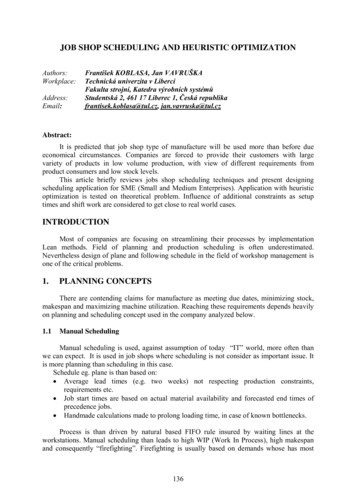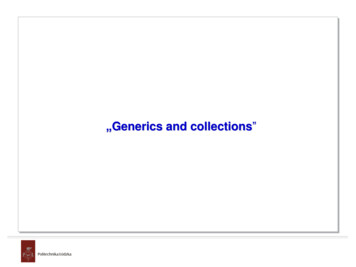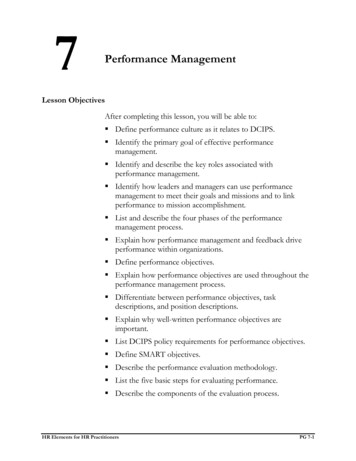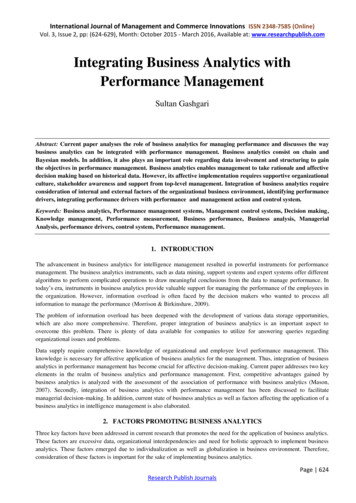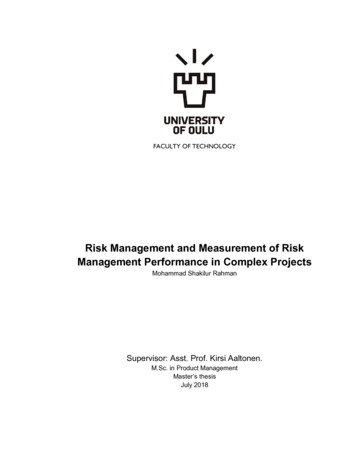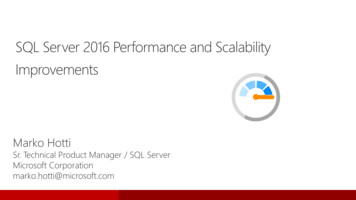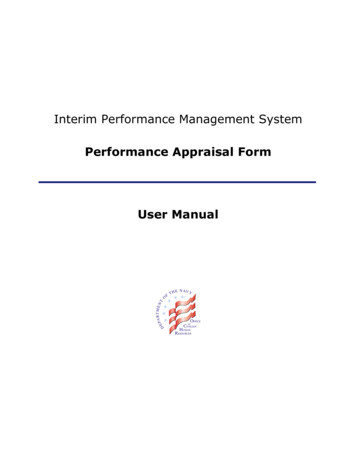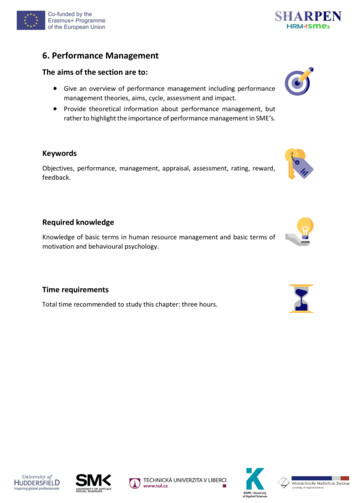
Transcription
6. Performance ManagementThe aims of the section are to: Give an overview of performance management including performancemanagement theories, aims, cycle, assessment and impact. Provide theoretical information about performance management, butrather to highlight the importance of performance management in SME’s.KeywordsObjectives, performance, management, appraisal, assessment, rating, reward,feedback.Required knowledgeKnowledge of basic terms in human resource management and basic terms ofmotivation and behavioural psychology.Time requirementsTotal time recommended to study this chapter: three hours.
ContentsIntroduction to performance management . 4Performance management theories . 4Goal theory . 5Control theory . 5Social cognitive theory. 5Aims of performance management . 5Guiding principles of performance management . 6Personal appraisal and performance management . 7The performance management cycle . 8Performance planning – performance agreement . 9Role profiles . 10Key performance indicators . 10Performance goals . 10Action planning . 10The performance management cycle in SMEs . 11Criteria for objectives . 12Managing performance throught the year . 13Performance review . 13Dealing with Underperformers (5 Steps) . 15Performance management issues . 15Performance management issues in SMEs . 15Performance assessment . 16Overall assessment . 16Rating . 17Visual assessment . 18Performance management as a reward process . 19Performance measurement models for SMEs . 19Performance management in SMEs (SHARPEN survey) . 22
Summary . 23Section review questions . 24Video links . 24Dictionary . 24Case studies . 25References . 27
Introduction to performance managementPerformance management (PM) is a process of identifying, measuring anddeveloping the performance of individuals and teams and aligning performancewith the strategic goals of the organisation (see Figure 1). According to Armstrong & Taylor(2014), PM comprises five elements: agreement, measurement, feedback, positivereinforcement and dialogue.It is important to highlight that performance management and reward management areclosely associated topics that play an important part in achieving one of the key goals of HRM– to contribute to the development of a high-performance culture. Performance is concernedwith how well a task or output is achieved and reward is about recognising individuals for theirachievements (Armstrong & Taylor, 2014).Figure 1. Performance management definitionSource: Armstrong & Taylor (as cited in Komulainen et al., 2019)Performance management theoriesFigure 2. Performance management theoriesSource: Adapted from Armstrong & Taylor (2014)
Goal theoryGoal theory, as developed by Latham & Locke (1979), highlights four mechanisms that connectgoals to performance outcomes:1) they direct attention to priorities;2) they stimulate effort;3) they challenge people to bring their knowledge and skills to bear to increase their chancesof success;4) and the more challenging the goal, the more people will draw on their full repertoire ofskills.This theory supports the emphasis in performance management on setting and agreeingobjectives against which performance can be measured and managed.Control theoryControl theory focuses attention on feedback as a means of shaping behaviour. As peoplereceive feedback on their behaviour, they appreciate the discrepancy between what they aredoing and what they are expected to do and take corrective action to overcome thediscrepancy. Feedback is recognized as a crucial part of performance management processes.Social cognitive theorySocial cognitive theory was developed by Bandura (1986). It is based on his central concept ofself-efficacy. This suggests that what people believe they can or cannot do powerfully impactson their performance. Developing and strengthening positive self-belief in employees is,therefore, an important performance management objective (see Figure 2).Aims of performance managementThe overall objective of performance management is to develop and improve theperformance of individuals and teams and, therefore, organisations.The aim is to develop the capacity of people to meet and exceed expectations and to achievetheir full potential to the benefit of themselves and the organisation. It is about ensuring thatthe support and guidance people need to develop and improve is readily available.Effective performance management has two other important purposes. First, it cancommunicate to employees the strategic goals of the enterprise and specify what theorganisation expects from them in terms of behaviour and results in order to achieve thosegoals. This means defining what doing a good job entails. Second, it can help with relationshipbuilding between employees and their managers. Involving both managers and their staff inperformance planning and review can widen the dialogue between them and enhance interpersonal trust.
A summary of what management and individuals can gain from performance management isgiven in Table 1.Table 1. What management and individuals can gain from performance management?Source: Armstrong (2015)Guiding principles of performance managementThe overarching principles governing effective performance management were defined byEgan (1995, p. 35): “Most employees want direction, freedom to get their work done, andencouragement not control. The performance management system should be a controlsystem only by exception. The solution is to make it a collaborative development system, intwo ways. First, the entire performance management process – coaching, counselling,feedback, tracking, recognition, and so forth – should encourage development. Ideally, teammembers grow and develop through these interactions. Second, when managers and teammembers ask what they need to be able to do to do bigger and better things, they move tostrategic development”.Strebler et al. (2001) suggested that the following principles are required for performancemanagement to work effectively: Have clear aims and measurable success criteria.Be designed and implemented with appropriate employee involvement.Be simple to understand and operate.Make its use fundamental to achieving all management goals.Allow employees a clear ‘line of sight’ between their performance goals and those ofthe organisation.Focus on role clarity and performance improvement.Be closely allied to a clear and adequately resourced training and developmentinfrastructure.
Make crystal clear the purpose of any direct link to reward and build in proper equityand transparency safeguards.Be regularly and openly reviewed against its success criteria.Personal appraisal and performance managementIt is sometimes assumed that performance appraisal is the same thing as performancemanagement. But there are significant differences. Performance appraisal can be defined asthe formal assessment and rating of individuals by their managers at, usually, an annual reviewmeeting. In contrast, performance management is a continuous and much wider, morecomprehensive and more natural process of management that clarifies mutual expectations,emphasizes the support role of managers who are expected to act as coaches rather thanjudges, and focuses on the future.Performance appraisal has been discredited because too often it has been operated as a topdown and largely bureaucratic system owned by the HR department rather than by linemanagers. It has been perceived by many commentators (e.g. Townley, 1989) as solely ameans of exercising managerial control. Performance appraisal tended to be backwardlooking, concentrating on what had gone wrong, rather than looking forward to futuredevelopment needs. Performance appraisal schemes existed in isolation. There was little orno link between them and the needs of the business. Line managers have frequently rejectedperformance appraisal schemes as being time-consuming and irrelevant. Employees haveresented the superficial nature with which appraisals have been conducted by managers wholack the skills required, tend to be biased and are simply going through the motions annually.It is better, probably, to ensure regular conversations for feedback rather than rely on annualappraisals. As Armstrong & Murlis (1998, p. 253) assert, performance appraisal too oftendegenerated into ‘a dishonest annual ritual’. The differences between them are summed upby Armstrong & Baron (2004) which are set out in Table 2.
Table 2. Performance appraisal compared with performance managementSource: Armstrong & Baron (2004)The performance management cyclePerformance management is a natural process of management: it is not an HRM technique ortool. As a natural process of management, the performance management cycle correspondswith plan-do-check-act model (see Figure 3).Figure 3. Performance management cycleSource: Armstrong & Taylor (2014)
Performance management includes processes of: performance planning, managingperformance, performance reviews and performance assessment recording the agreementand review, and the use of web-enabled technology (see Table 3).Table 3. Summary of performance management activities over the yearSource: Armstrong & Taylor (2014)Performance planning – performance agreementA performance agreement is the outcome of the decisions made jointly by the manager andthe individual during the planning part of the performance management sequence. It providesa foundation for managing performance throughout the year and for guiding improvementand development activities. It is used as a reference point when planning and reviewingperformance and is therefore a key component of a performance management system. Itcontains agreements on expectations in the form of the results, competencies and actionsrequired, defined as performance and learning goals, and on action plans to developperformance and abilities. The basis for these agreements is a role profile which is jointlydeveloped by the two parties (Armstrong, 2015).
Role profilesAn important part of performance planning is the agreement or updating of a role profile forthe role holder. A full role profile defines: Overall purpose – what the role exists to achieve. Key result areas – elements of a role for which clear outputs and standards exist, eachof which makes a significant contribution to achieving its overall purpose. It is best torestrict KRAs to no more than five or six. Knowledge and skill requirements – what the role holder should know and be able todo. Behavioural competency requirements – the types of behaviour required for thesuccessful performance of a role.However, the process may be made less complex for line managers by grouping togetherknowledge and skill and behavioural competency requirements under the heading of ‘criticalsuccess factors’ or ‘role requirements’ meaning those aspects of a role that must go well toensure success.Key performance indicatorsKey performance indicators (KPIs) are the metrics or other sources of information whichindicate how outcomes can be measured or recognised.Performance goalsPerformance goals define the results individuals are expected to achieve. The expected resultswill be defined within the framework of the role profile and by reference to the keyperformance indicators established for key result areas. Wherever possible, goals arequantified as targets which indicate what has to be achieved over a period of time in terms ofquantified results or the completion of a project. But they can be expressed as qualitativeperformance standards which state that a key aspect of the job will have been well done ifsomething specific happens.Action planning1. Achieving goals – any actions required by the individual and the manager to achievethe overall objectives of the job.2. Performance development plans – these will spell out what employees in conjunctionas necessary with their managers, need to do I specified areas of their jobs such asreaching sales or productivity targets, working accurately, providing services tointernal customers, cutting costs, reducing waste, meeting deadlines. In anydevelopment area, goals are set on what has to be done and by when, and agreement
reached on how the expected results will be achieved. If there are any behaviouralperformance problems such as being uncooperative or lack of effort, plans are agreedon how the problems can be overcome. The plan should be focused; too many goalswill only dissipate improvement efforts.3. Personal development plans – learning plans to achieve learning goals for whichindividuals are responsible with the support of their managers and the organisation.The performance management cycle in SMEsFor SMEs, the adoption of advanced managerial practices in the main business processes iskey to the successful improvement of their business performance and competitiveness.However, it is well known from the literature that SMEs experience difficulties in adoptingnew and innovative managerial practices (Cagliano et al., 2001). Therefore, there is a clearneed to stimulate the development of managerial capability in SMEs considering the factorscharacterizing these companies.SMEs exhibit different managerial characteristics from larger organisations. The small firm isnot a scaled-down version of a large firm and we cannot simply look at the needs of SMEs byadapting policies and practices from larger firms in smaller enterprises.Ates, Garengo, Cocca & Bititici (2013) argued that in order to support the development ofmanagerial practices to improve organisational performance SMEs experience particulardifficulties. Authors emphasize that SMEs seem to be more focused on internal and short-termplanning, whereas they spend less effort in possessing a long-term view on internal andexternal issues, such as communication, competition, sustainable competitive advantage,strategic market positioning and horizon scanning. SME managers should become moreconscious that development on the path to short-term performance does not lend itselfsimply to changing at a later stage to the long-term path.Planning seems to be the most crucial phase of the identified closed-loop process. SMEs showdifficulties in developing effective mission, vision and values, and most of them have neverformalised their strategies. However, reference frameworks available in the literature for theimplementation of a performance management system are based on a top-down approach,i.e. they establish performance measures starting from the identification and formalization ofthe company’s mission and vision (Cook & Wolverton, 1995; Garengo, Biazzo & Bititci, 2005;Hudson et al., 2001) without considering that SMEs have difficulties in managing conceptssuch as mission and vision. To support the development of managerial practices first of all, weshould support SMEs to unveil their strategy without forcing SMEs to adopt the same complexmethodologies used by large organisations, but proposing an approach that complies withcharacteristics and managerial culture of SMEs. The literature is developing in this direction;see, for example, the bottom-up approach proposed by Garengo & Biazzo (2012) to guideentrepreneurs and managers to unveil mission vision and strategy. However, further researchshould be carried out to develop an SME-friendly, visual strategic framework for guidance.
A second key barrier that SMEs should tackle to develop their managerial practice is thedifficulty in managing the internal and external communication process. How can firmsdevelop their performance practices without communicating with employees, customers andsuppliers? It is clear that this is an internal contradiction that it is sometimes determined bydistorted performance management practices, i.e. the collection of information to blameemployees for negative performance, instead of improving the overall company performance.This also means to tackle the traditional command and control management style. There is aclear need to reinvent the management style in SMEs to move towards empowered andinformation-based organisations, similar to the recommendations made by Gary Hamel(2009). However, given the large diffusion of command and control approach in SMEs and thedifficulty in changing that behaviour in the short term, the entrepreneur’s commitment to thecontinuous development of managerial practices becomes crucial.Thirdly, special attention should be given to the planning and communication of internal andexternal change initiatives. If top management does not pay attention to managing changeeffectively, the PM process will inevitably be affected. The main challenge is that criticalchange steps, particularly the soft aspects of change, are omitted. SMEs should take a morestrategic and long-term view of change rather than seeing it as project management only.Changes should be driven proactively rather than waiting until change is imposed by externalforces such as customer complaints and changes is legislation (Ates & Bititci, 2011; Burnes,2004; Gray, 2002).Criteria for objectivesThe acronym ‘SMART’ is often used to define a good objective. Traditionally, S stands forspecific (sometimes ‘stretching’), M for measurable, A for agreed, R for realistic and T fortime-related (see Figure 4). But as Chamberlin (2011) argued, ‘the real aim of settingobjectives is for people to know exactly what it is they have to do, when they’ve done it, thatthey are able to do it, why they have to do it (i.e. who for) and that it is something they shouldbe doing, and how they are progressing along the way’. Following Blanchard (1989), hesuggested that the last three letters of the mnemonic should be amended to read A forattainable, R for relevant and T for trackable. He attached particular importance first to‘relevant’, meaning that the objective is to do with the business and its customers. Second,he emphasized ‘trackable’ because the important thing to do with objectives is to monitorprogress over time, i.e. track it (he rejected ‘time-related’ because it did not convey thisessential feature and was in any case covered already by ‘specific’).
Figure 4. Criteria for objectivesSource: Adapted from Armstrong & Taylor (2014)Managing performance throught the yearPerformance management should not feel like a forced task for managers, but something thatis natural throughout the year. Appraisals are seen as disadvantageous as they focus and dwellon the past rather than what is at hand. Performance management can continue to improveon someone as yearly reviews will not focus on what is current and give certain goals for awhole year (Armstrong & Taylor, 2014).Performance reviewA performance review provides a focal point for the consideration of key performance anddevelopment issues. The performance review meeting is the means through which the fiveprimary performance management elements of agreement, measurement, feedback,positive reinforcement and dialogue can be put to good use. It leads to the completion of theperformance management cycle by informing performance agreements.There are 12 golden rules for conducting performance review meetings:1. Be prepared. Managers should prepare by referring to a list of agreed objectives andtheir notes on performance throughout the year. They should form views about thereasons for success or failure and decide where to give praise, which performanceproblems should be mentioned and what steps might be undertaken to overcomethem. Thought should also be given to any changes that have taken place or arecontemplated in the individual’s role, and to work and personal objectives for the nextperiod. Individuals should also prepare in order to identify achievements andproblems, and to be ready to assess their own performance at the meeting. Theyshould also note any points they wish to raise about their work and prospects.
2. Work to a clear structure. The meeting should be planned to cover all the pointsidentified during preparation. Sufficient time should be allowed for a full discussion –hurried meetings will be ineffective. An hour or two is usually necessary to getmaximum value from the review.3. Create the right atmosphere. A successful meeting depends on creating an informalenvironment in which a full, frank but friendly exchange of views can take place. It isbest to start with a fairly general discussion before getting into any detail.4. Provide good feedback. Individuals need to know how they are getting on. Feedbackshould be based on factual evidence. It refers to results, events, critical incidents andsignificant behaviours that have affected performance in specific ways. The feedbackshould be presented in a manner that enables individuals to recognize and accept itsfactual nature – it should be a description of what has happened, not a judgement.Positive feedback should be given on the things that the individual did well in additionto areas for improvement. People are more likely to work at improving theirperformance and developing their skills if they feel empowered by the process.5. Use time productively. The reviewer should test understanding, obtain information,and seek proposals and support. Time should be allowed for the individual to expresshis or her views fully and to respond to any comments made by the manager. Themeeting should take the form of a dialogue between two interested and involvedparties, both of whom are seeking a positive conclusion.6. Use praise. If possible, managers should begin with praise for some specificachievement, but this should be sincere and deserved. Praise helps people to relax –everyone needs encouragement and appreciation.7. Let individuals do most of the talking. This enables them to get things off their chestand helps them to feel that they are getting a fair hearing. Use open-ended questions(i.e. questions that invite the individual to think about what to reply rather thanindicating the expected answer). This is to encourage people to expand.8. Invite self-assessment. This is to see how things look from the individual’s point ofview and to provide a basis for discussion – many people underestimate themselves.9. Discuss performance not personality. Discussions on performance should be basedon factual evidence, not opinion. Always refer to actual events or behaviour and toresults compared with agreed performance measures. Individuals should be givenplenty of scope to explain why something did or did not happen.10. Encourage analysis of performance. Don’t just hand out praise or blame. Analysejointly and objectively why things went well or badly and what can be done tomaintain a high standard or to avoid problems in the future.11. Don’t deliver unexpected criticisms. The discussion should only be concerned withevents or behaviours that have been noted at the time they took place. Feedback onperformance should be immediate; it should not wait until the end of the year. Thepurpose of the formal review is to reflect briefly on experiences during the reviewperiod and, on this basis, to look ahead.12. Agree measurable objectives and a plan of action. The aim should be to end thereview meeting on a positive note (Ahmad & Alaskari, 2014).
Dealing with Underperformers (5 Steps)1.Identify and agree the problem – provide feedback and make sure the employee agreeson the issue.2.Establish the reasons for shortfall – this is not to provide blame. This is to look at thefacts and discuss them with the employee.3.Decide and agree on action required – actions may be taken by the manager,employee, or both. Arrangements for feedback can be made for the action.4.Resource the action – managers can provide training, coaching, facilities, etc.5.Monitor and provide feedback – this is to make sure the proper actions are being takento correct any problems. If the actions are not working, feedback can be given and new planscan be put in action (Armstrong, 2015).Performance management issuesThe many-faceted nature of performance was commented on as follows by Cascio (2010, p.303): ‘It is an exercise in observation and judgement, it is a feedback process, it is anorganisational intervention. It is a measurement process as well as an intensely emotionalprocess. Above all, it is an inexact, human process.’As a human process, performance management can promise more than it achieves. Howeverwell designed a performance management system is, its effectiveness mainly depends on thecommitment and skills of line managers (Armstrong & Taylor, 2014).Performance management issues in SMEsLack of human resources. SMEs typically have limited human resources. Often all the staff areinvolved in the activities of managing daily work, and have no extra time for additionalactivities, such as implementing a PMS (Barnes et al., 1998; Hudson et al., 2000; Hvolby &Thorstenson, 2000; McAdam, 2000; Noci, 1995; Tenhunen et al., 2001).Managerial capacity. Technical excellence in products and operational processes is oftenperceived as the only key critical factor in SMEs. A managerial culture is often lacking in thesecompanies and therefore managerial tools and techniques are perceived as being of littlebenefit to the company. Very often, employees occupy different positions at the same time,the organisations are flat, and though the entrepreneur is in charge of both operational andmanagerial functions, he/she usually neglects the managerial activities (Marchini, 1995).Limited capital resources. The impact of the resources needed to implement a PMS isproportionally more onerous in SMEs than in large companies (Barnes et al., 1998; Burns &Dewhurst, 1996; Ghobadian & Gallear, 1997; Hudson et al., 2000; Hvolby & Thorstenson,2000; Neely & Mills, 1993; Noci, 1995). Moreover, the absence of affordable softwareplatforms that focus on the specific needs of SMEs further obstructs the introduction of PMSin these companies (Bititci et al., 2002).
Reactive approach. SMEs are characterised by poor strategic planning and decision-makingprocesses are typically not formalised. The lack of explicit strategies and methodologies tosupport the control process promotes both a short-term orientation and a reactive approachto managing the enterprise’s activities (Brouthers et al., 1998; Marchini, 1995).Tacit knowledge and little attention given to the formalisation of processes. One of the mainbarriers to organisational development in SMEs is the lack of a managerial system andformalized management of the processes. Furthermore, since knowledge is mainly tacit andcontext-specific, the information required to implement and use a PMS is difficult to gather(Jennings & Beaver, 1997; Marchini, 19
The performance management cycle Performance management is a natural process of management: it is not an HRM technique or tool. As a natural process of management, the performance management cycle corresponds with plan-do-check-act model (see Figure 3). Figure 3. Performance management cycle Source: Armstrong & Taylor (2014)
